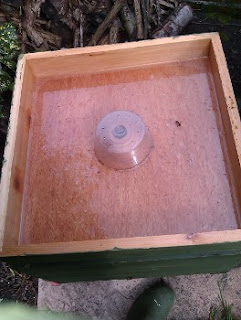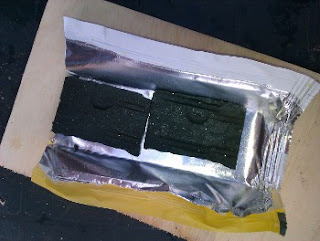Been a while since my last entry. Fact is as the temperature drops and winter approaches there's less for the beekeeper to do. The bees give up the urge to swarm, in theory anyway, and things start to calm down for the winter, so now there's no more need to open up the hive and check every frame for a few months. Ideally having made a shedload of honey the bees should be all set for a winter of happpily eating honey and staying warm. However what happens to honeybees in hives is some bloke comes along and steals most f the honey they've made. Oh dear. Hard life for a honeybee.
Luckily beekeepers are bright enough to know to feed the bees up for winter. What we feed them is syrup. The syrup is made from ordinary granulated sugar the sort you'd buy from Tesco for the coffee club at work -or if you're a bit thrifty from Wilkinsons who sell the same stuff for a little less.
The syrup for winter is thicker than the syrup given in the spring and the recipe varies depending who you ask. some will tell you it's 2KG of sugear to 1 litre of water, others will say it's 2 lb of sugar to 1 pint of water, and about umpteen other slight variations on a more or less 2:1 theme. To make it you just get a humongous pan, measure out the sugar and water then heat it up till it's melted then wait around whilst it cools.
 |
One pan of winter syrup.
(Possibly not the most exciting picture ever placed on the internet.) |
The syrup then goes into a feeder of some description. There's a lot of different feeder types. Ask a handfull of beekeepers about the merits and shortcomings of the different types and they'll all quite happily give you conflicting information all the while insisting they're right and nobody else knows what they're talking about. Beekeepers are like that.
Aaaaaaaanyway the feeders I've opted to use are called Brother Adam Feeders. You're probably thinking "Who the hell is Brother Adam?" He was a benedictine monk born in Germany in 1898, at the age of 11 he went to live at Buckfast Abbey. In 1916 whilst mankind was busy trying to wipe itself out with World War I the humble Honeybee was being wiped out across the UK by a tracheal mite called
acarapis woodi. It was probably a pretty crap time to be a honeybee. Brother Adam started a breeding program to develop a bee that was resistant to the mite as well as relatively easy to handle and with a good honey yield. His end product was the
Buckfast bee which we're still using nowadays. They contain DNA from Italian, English, French, Turkish, Greek and African honeybees.
Brother Adam is attributed with inventing a kind of feeder. some people swear blind that he didn't and it's just named after him. Although it strikes me that a guy who spent 77 years in beekeeping and was bright enough to develop a strain of bees to suit our climate and survive a devastating disease which wiped out most of the nations original honeybees was quite probably bright enough to make a wooden box and drill a hole in it. The Adam's Feeder is essentially just that. A box with a hole in the middle. There's a little island bit in the middle that the bees can climb out of from underneath to get to the syrup and a small bowl over this to limit the bees access to the reserviour.
 |
| Adam's Feeder |
You need to limit bee acess to the reserviour otherwise they'ed drown in the syrup. As you can see from my picture a bee managed to get into the syrup before I had chance to pop a cover onto it. Don't worry tho, I rescued her. The reserviour is waterproofed by being treated with varnish, although some people prefer paint, and other's molten wax -whatever rocks your boat, and the whole thing sits on top of the hive. The bees climb up into the island in the bowl get some syrup and take it back down into the hive to store, no doubt grumbling all the that some idiot stole all their honey and now they're having to faff about with sugar syrup. Waterproofing these two took a while as there was a few knots in the wood which no matter how many coats I tried kept leaking when I tested it with water before putting them on the hives. I the end I turned them on their sides and poured varnish into the knots then left them to dry. Seems to have done the trick.
 |
| Bees using Adams Feeder |
When the feeder is almost empty you remove the plastic bowl and let the bees have full rein of the reserviour. In theory they then pick it completely clean, what I've found is that the sugar crystalises a bit a the bottom and the bees have trouble removing it but the wet stuff they manage with just fine. When you take the bowl off the bees come boiling up out of the island it's like a little bee volcano. With this feeder you can add more syrup to top it up without having to remove it from the hive making it prety handy for bulk feeding..













